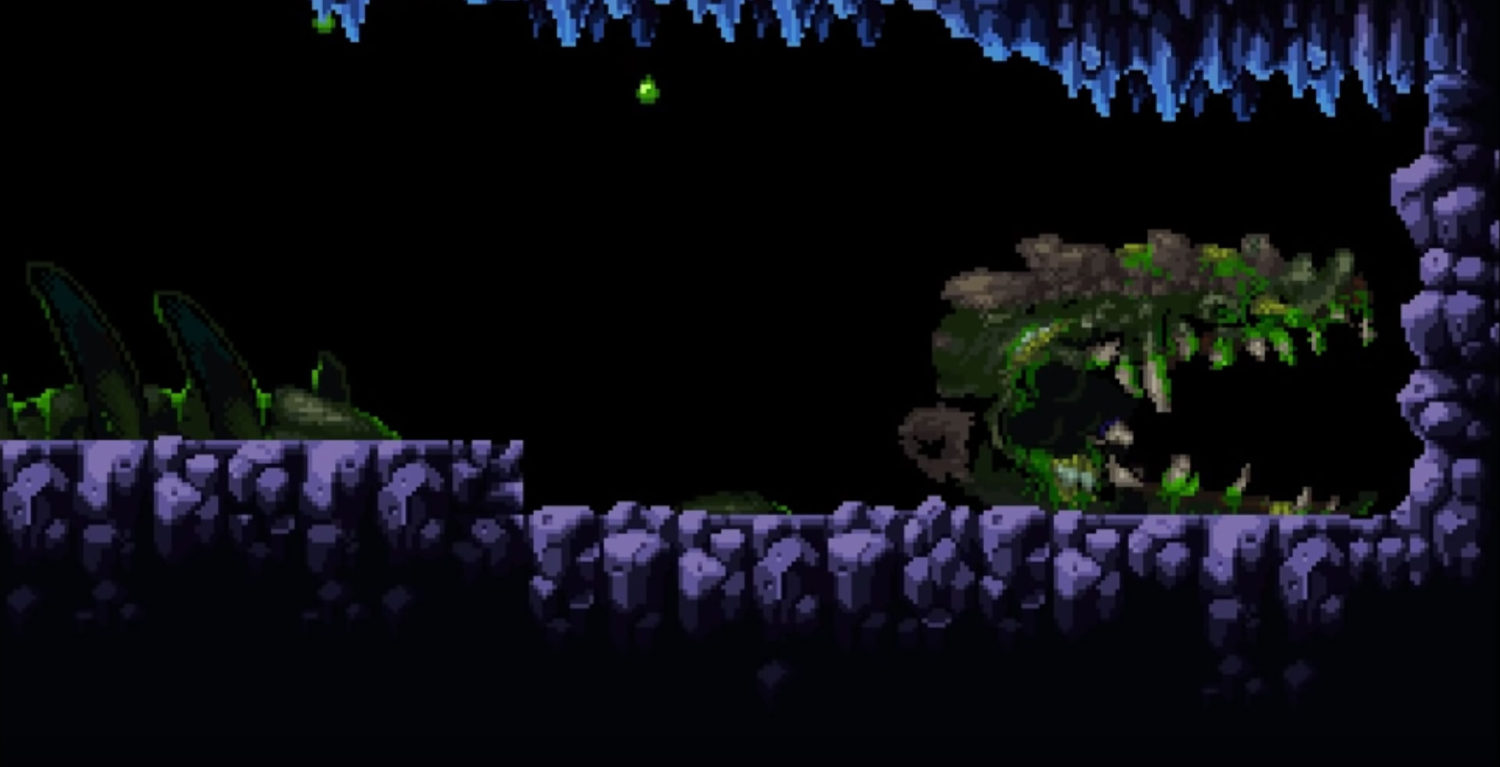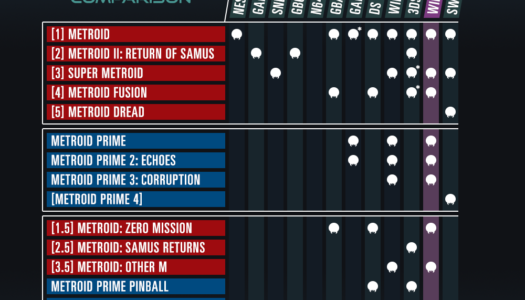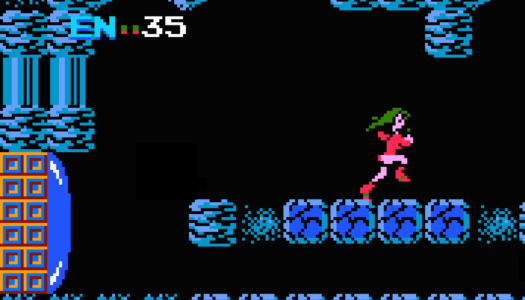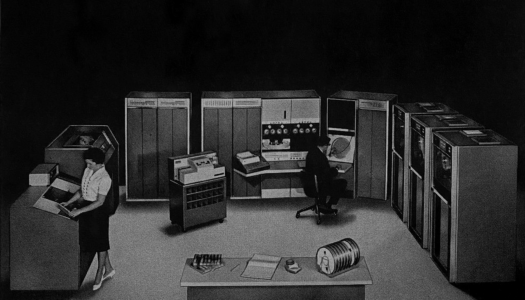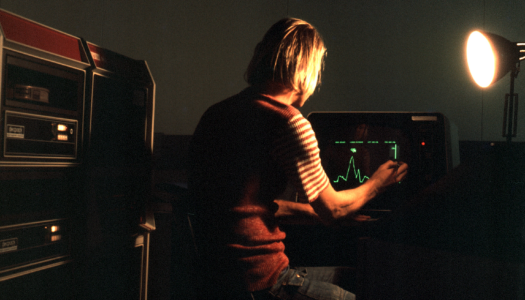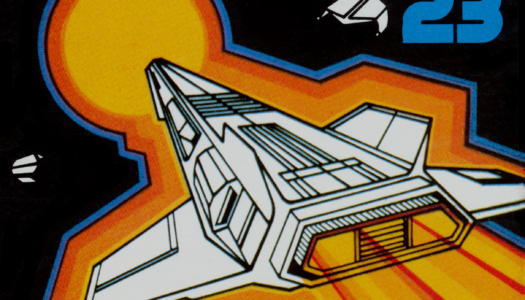AM2R is a decent freeware indie game, and a passable Metroid game, but a very misguided attempt at remaking Metroid 2.
It’s hard to critique a remake. There’s always the question of whether you should judge the thing on its own merits, or hold it to the standard set by the original. This is even more true when comparing a freeware labor of love with a commercially released product. I could be sanguine about this and pretend the original game doesn’t exist, or I could put on my grognard hat and harp on the remake’s shortcomings.
Unfortunately, for reasons that will soon be clear, AM2R is forcing me into the grognard hat.
I’ll get two things out of the way before I dig in.
First, Metroid 2: The Return of Samus is my favorite game in the franchise, and one of my favorite games period. This isn’t a product of rose tinted lenses; it was only a year and a half ago that I first played it through, and I had already played most of the other Metroid games before then. I’m also very aware of the game’s (numerous) flaws and badly aged gameplay, all of which I would be happy to see corrected. Which AM2R did, mostly.
Second, while I’m going to seem very harsh on this game, please understand that I don’t hate it. I’m glad that it was made, and I’d be even gladder to see more fan projects like it. One of the main reasons I’m writing this is so that we can learn from the failures of AM2R as well as its successes.
SPOILERS for AM2R and Metroid 2 beyond this point.
The Purpose of a Remake
The way I see it, there are two good reasons why you would want to remake a classic. The first is that you have an artistic vision of how things could be reimagined, and want to make an alternate version that presents your own take on the game. The second is that the original is flawed or outdated, and you want to keep everything good about the original while rectifying its flaws. AM2R is very obviously of the second type. The original’s structure, gameplay conventions, and basic sequence of events are unchanged, and the developer’s blog makes it clear that he remade the game one area at a time, updating and reimagining things as he went along rather than having a strong vision from the outset.
So, what about Metroid 2 makes it worth rectifying? What aspects of it should be captured while the rest is changed?
Metroid 2 has some of the best atmosphere of any game I’ve ever played (impressive, given the GameBoy’s limitations), and the best environmental storytelling. Not only is it one of the most earnestly Lovecraftian videogames to not literally have Cthulhu in it, Metroid 2 managed to have foreshadowing, complicated narrative, a character arc, and a strong message, all without a single word of text. That’s what makes Metroid 2 great. If you’re not going to do your level best to keep those aspects, AND you don’t have a compelling vision of your own to replace them with, there’s no reason to remake Metroid 2 besides nostalgia. You might as well make an original Samus fangame.
I’ll show you what I mean by nostalgia.
Upon reaching the final boss of Metroid 2‘s lair, the player is greeted with the sight of a chozo item-bearer statue smashed off its pedastal, the ice beam it once clutched lying on the floor in its broken hand. This is the only place in the game with a broken statue, and the rage and violence with which it was shattered are immediately apparent. This room serves a gameplay function (giving the player an ice beam), a metagame function (warning the player that a very powerful creature that can break these ancient statues is up ahead), and a narrative function (the metroids’ destruction of the icon of their creators tells us how they turned against them, and how all the chozo’s advanced weaponry wasn’t enough to save them).
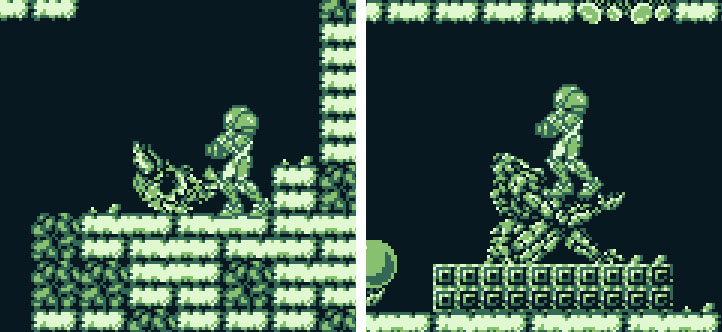
In AM2R, the player already has an ice beam by this point, and a broken statue means nothing because the game has already shown them many broken statues. In fact, the player has even seen a similar statue get smashed into much smaller pieces than this one onscreen by a random miniboss monster. And yet:

Here’s another moment from just a couple rooms later. Throughout Metroid 2, the player is shown how many metroids they still need to kill to beat the game. By the time they enter the final area, that counter has been reduced to 1, indicating that only one metroid (presumably the final boss) remains. But, as the player moves deeper into the area, they see what looks like an alien egg on the other side of a wall. Just as the egg comes onscreen there’s eerie music, and the metroid counter changes from 1 to 9. This informs the player that the remaining metroid is an egg-laying mother or queen, and that she’s replenishing her brood even now. Once again, this serves multiple functions in warning the player about newborn metroid enemies, and relaying the narrative of how metroids reproduce. Its also a heart-stopping “holy shit” moment in an already tense and creepy sequence.
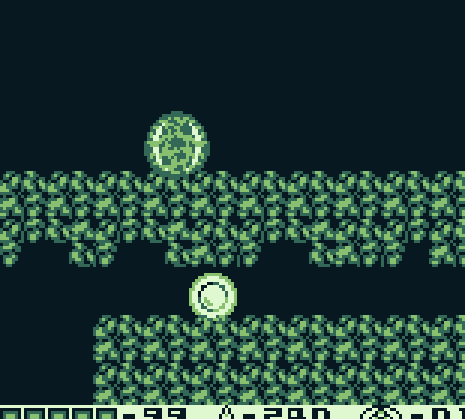
In AM2R, the metroid counter only tells you how many metroids are left in a specific area, not in the entire game world. And that’s fine. However, when you come to that same moment in AM2R, your metroid counter is at 0 (as it always is upon entering a new zone), and it jumps straight to 9 when you pass the egg in the same manner it did upon entering all the previous areas. It still plays the scary music and freezes the gameplay for a second, but because of the way the counter works you have no idea why the nine metroids in this area are any different from those in the previous areas. In fact, you’re not even sure if the weird round thing on the screen is a metroid egg, because the game doesn’t communicate the concept of metroid reproduction in time with the object’s appearance.
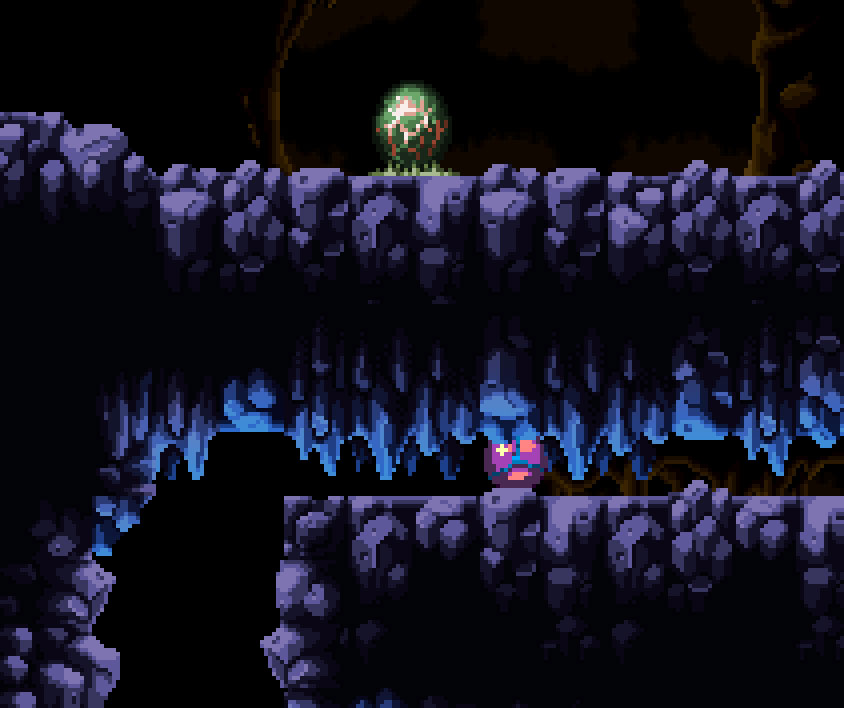
Why did AM2R keep the dramatic freeze and music here? Hell, why did it even keep the metroid counter at all if it wasn’t going to be used for storytelling moments like this?
These are just two examples fresh in my memory from right near the end of the game. There are a hundred others. AM2R constantly goes out of its way to remind you of the original game, even when there’s no longer any purpose to those details.
This is why I can’t review AM2R on its own merits. It doesn’t WANT to be reviewed on its own merits. In fact, I’m not sure its intended audience extends beyond people who played the original Metroid 2. Well, okay game, you asked for it.
Gameplay and Level Design
There are many layers to good game design. There’s the obvious things, like user interface, controls, and functionality. On a more advanced level, there’s pacing, tutorializing, and managing the line between challenge and frustration. Finally, there’s the way that the game elements synergize to create an overall style of play, and how that playstyle in turn helps create a specific kind of experience.
AM2R does a very good job at the first layer of design, which is where the original Metroid 2 was most lacking. The addition of a map makes navigation much less frustrating while still finding ways to keep up the challenge. The larger screen and higher resolution makes it much, much easier to avoid enemies and see where you’re going (probably the single biggest flaw in the original). The menu controls have some issues, but Samus handles at least as well as she does in the official GBA titles (Metroid Zero Mission and Metroid Fusion), and the addition of later series improvements like consolidated save and recharge stations, ledge-grabbing, diagonal aiming, and the charge beam are all necessary updates. There are also some new gimmicks it adds (like an area full of elaborate puzzles based on guiding fuel cells into unpowered machinery to reactivate it, or one spot where Samus takes remote control of a robot and uses it to clear a path for herself) that are tons of fun and show a lot of creativity on the part of the devs. The levels are all functional and fun to navigate through, a few of them even rivaling those of the official titles. There are some errors here and there – especially in the early areas of the game – including some tiling errors that look like something you’d expect from a ROMhack and a few patches of ceiling that inexplicably make my spiderball shut down and drop me to the floor, but these are practically nonexistent beyond the second area or so.
The second layer of design has plenty of hits, but also its share of misses. Metroid 2 had some very unfairly frustrating bits (mostly due to stingy save station placement and lack of health pickups after the grueling metroid battles), but its pacing was solid all the way through, and the level design did a good job of teaching you how to play and where to use each new powerup to advance. In AM2R, well…
There’s one point where the game locks you in a small loop-shaped cluster of rooms with a difficult boss and no save stations or lesser enemies to kill for pickups. The doors to the boss’ room are open and unlocked, and it looks like the game is inviting you to flee if the fight goes against you (you can also be accidentally knocked out of the room by the boss’ attacks, if you happen to be perched near the left entrance). Once you leave that room though, you’re still trapped in the area with no save stations or pickups, and unlike you the boss will have healed completely when you return to his room. There’s nothing to do but restart the game and replay the whole sequence leading up to that boss (including an annoying bit of backtracking and another metroid fight) from the last save. No part of Metroid 2 was as poorly designed as this. There’s an even more egregious example slightly earlier in the game, where – at the end of a very lengthy and frustrating timed escape sequence – the game arbitrarily reduces the player to 5 hp regardless of how fast they were, and then forces them to navigate through a few rooms of tough enemies before they can get to a save station. If anything touches you, you need to do the entire escape sequence over again, including a boss fight. Fake difficulty at its finest, and again, much worse than any one bit of bad level design in the original. While AM2R does fix some of Metroid II’s save station and health placement issues, it replaces each gaffe with a new one.
Speaking of timed escapes, let’s talk about pacing. AM2R has almost no pacing. There’s no rising and falling action. No rhyme or reason to the placement of power ups, boss fights, and new areas opening up. For instance, in every Metroid game to have a timed escape sequence so far (and in most games of ANY franchise that has them), the escape has either been at the beginning of the game to separate the intro/tutorial level from the game proper, or at the end as a climactic heart-thumping challenge after defeating the final boss (the exception being the mediocre Metroid Prime Hunters single player campaign, which was roundly criticized for it). AM2R‘s timed escape happens in the middle of the game without marking any sort of transition or carrying any weight in game progress beyond giving you a new, mid-game item. It comes out of nowhere with no buildup and no consequences. I’m pretty sure the only reason its there is because other Metroid games have timed escapes, so the devs thought they should shoehorn one in somewhere regardless of weight or pacing. In some areas of the game (specifically, those adapted most closely from the original), each item acquisition is followed by some chances to learn to use it and a few challenges leading up to the next major item. In another, completely new to AM2R, section, you wander around for a long static time before getting the gravity suit, screw attack, and ice beam one after another before you even have time to think, and then are thrown straight into an extremely slow-paced boss fight. What am I supposed to be feeling during this sequence? Where is the tension and release?
The synergistic level is where AM2R fails the most. The best games in the series have all assembled their game mechanics to create a very deliberate kind of experience. In Super Metroid, you have a sprawling, interconnected world full of finnicky little item and enemy interactions, and most of the game’s powerups are designed to deal with a specific kind of obstacle; the experience is one of empowerment through exploration and victory through creative problem solving. In Metroid Fusion, there’s a strong emphasis on weaponry, a repeating motif where something terrible happens after each minor victory that snatches the triumph away from you, and hidden connections between areas that only become available in the late game; the experience is one of fleeing a terrifying enemy, staying barely one step ahead of it, and only at the end conquering the game world and confronting that great enemy. Metroid 2: the Return of Samus gives the player the greatest menu of movement-related items early in the game (spring ball, high jump, space jump, and spider ball all by the mid game), but Samus’ actual movement speed remains fairly slow, and the low screen resolution (irritating though it is) prevents reckless progress. The game world is designed as a series of mini-metroidvanias arranged along a linear path, each of which must be cleared of metroids before the path forward becomes available. The experience these elements create is a slow, methodical search-and-destroy mission, where you use Samus’ great range of motion to slowly but completely scour each area for targets before moving on. Each area cleared leads to another, even worse one, every step brings you deeper into the hive.
AM2R keeps the linear world with mini-metroidvanias, but throws in the speed booster and ups Samus’ basic speed to the hyperactive pace of Metroid Zero Mission. Worse, it adds backtracking between areas to a completely linear game. A full reimagining of Metroid 2 with an interconnected world like Super Metroid or Metroid Prime‘s would have been fine; you’d be hard pressed to keep the original’s sense of escalation and constant descent into hostile territory, but with good level design it could be worth the cost. Unfortunately, the way the game shoehorns backtracking in is by adding optional side-areas that are completely tangential to the main ones, and then adding a warp system that’s only available once you reach the penultimate area of the game. For instance, near the second area of the game there’s a side-section that you need the Space Jump to access, but you only get the Space Jump in area three. In order to get back to that side-section, you need to go back through the same long, linear, boring pathway that you just came through (and then come back through it AGAIN immediately after that to continue making progress in the game), or wait until the game is almost over so you can use the warp system (and even then, the nearest warp point is pretty far away and requires backtracking through that linear main tunnel). The final area, and the (very) long and nearly item-less hallway leading up to it, don’t have warp points at all, so if you realize that you’ve missed something at that point you need to walk all the way back to the warp hub, and then return the same way.
I followed the developer’s blog, and played some of the demo versions of the early areas. I therefore know, with 100% confidence, that the dev made each area up as he went along, and only tacked on those side-areas retroactively after he came up with the warp area toward the end of the game’s development. If the intent was to keep AM2R a linear series of self contained levels like the original, that design philosophy would have worked fine, but the game world was not designed to facilitate backtracking and non-linear exploration. Its addition is frustrating, inconvenient, and very poorly paced. As with the escape sequence, I’m forced to conclude that it was only shoehorned in because backtracking is a staple of most other Metroid games, without regard for the fact that those other titles – unlike Metroid 2 – were designed from the ground up to accommodate it.
Consequently of all this, AM2R doesn’t create a memorable experience so much as a grab bag of random elements (well executed individually, but oblivious in arrangement) from different titles in the series, and the only taste it leaves is that of blind fandom. Its more playable than Metroid 2 on the immediate level of controls and response times and screen resolutions, but fails to improve on its overall level design and pacing, and is a massive step back in terms of emergent gameplay. AM2R was crafted with a very good understanding of basic video game design (aside from the occasional save station-less loop), but a poor grasp on the more advanced theory.
Atmosphere and Environmental Storytelling
Imagine a choked, half-flooded tunnel that suddenly opens into a vast dome-shaped cavern, hundreds of meters tall and hundreds across. In the center of this cathedral-like cavern, a windowless tower of black stone rises from a lake of slowly dying magma. Past the millennia-sealed blast doors of the tower, ancient weapons of terrible power are locked away. The outer walls of the black tower are honeycombed with the burrows of horrific creatures, and a sickly, alien growth has crept from the many side-tunnels of the cavern and covered parts of the walls with barbed and twisted organic blades.
Okay, now light it up with fluorescent lighting and monitor screens, fill the tower with cheerful-looking maintenance robots hovering about their business, and play an upbeat techno song over it. From At the Mountains of Madness to Revenge of the Sith, just like that.
At very few points in the game did I feel the dread, isolation, or foreboding of the original (a special mention goes to the dark industrial sublevel of area 3, which does by far the best job of preserving this. I wish the whole of AM2R had been more like that). Part of this can be attributed to the bad pacing discussed in the previous section. Part of it is also down to the game’s aesthetics, with most areas’ music consisting of upbeat techno-remixes of (seemingly randomly chosen) songs from the series, and the visual style copying Metroid Zero Mission‘s flat, comic book like appearance. Some of the art assets are actually lifted from Zero Mission, including at least one complete cave tileset and a number of backgrounds. This art style worked in Zero Mission because that game was clearly going for a fast paced, shonen anime or satam cartoon “biff pow” sort of feeling, and the rest of the game’s elements also helped facilitate that. AM2R isn’t going for the satam feel, for the most part, but the graphics suggest otherwise. This might be the least immersive metroidvania-genre game I’ve ever played, and that includes several indie freeware titles (if you want proof, download HeroCore. Ten times the immersion and atmosphere with one tenth the production values). I can’t even describe AM2R‘s atmosphere, because very little of the game succeeds at having one. The rest just registers as colors and sounds. What’s really unfortunate about this is that a lot of AM2R‘s art and music is technically excellent. Several of the original backgrounds (especially those for the planet’s surface and the final dome cavern) are gorgeous, and the queen metroid’s sprites in particular are some of the best in all of indie gaming. Like the backtracking and the linear game world, they’re just badly mismatched.
Metroid 2‘s best feature is its environmental storytelling. Each of the chozo ruins you visit throughout the game seems to have a darker purpose than the last. The first looks like a temple or a monastery. The next is some kind of light industrial facility, all pipes and chambers. The next is a dark, grimy factory, and the next is a military fortress full of nothing but weapons and war machines. Finally, the player reaches the lab complex where the metroids were created – the ultimate sin of the ancient chozo and the one that finally destroyed them. Throughout the game, the player follows the ancients’ descent into violence, and becomes more like them every step of the way by gathering their weapons and using them on everything that moves. But then, after killing the final boss, Samus decides to spare its last hatchling, and the hatchling imprints on her and helps guide her back to the surface, communicating the redemption of both the metroids and of Samus.
The game’s advertising slogan, by the way, was “destroy, or be destroyed.” Undertale was twenty-four years late to the party.
There are many smaller, subtler bits of environmental storytelling throughout the game. The only non-metroid boss in Metroid 2 is a creature, encountered early in the game, that bears some odd similarities to the advanced metroid stages you won’t meet until much later. When you find this creature, it is curled up in a ball in the hands of a chozo statue mimicking an item, it employs a morph ball ability similar to your own during the battle, and it drops a chozo artifact when killed. The implications are obvious in retrospect; this organism is synthetic, hence its ability to integrate with and use chozo technology, and might have been an early precursor to the advanced metroid stages (or perhaps one of the genetic “ingredients” that went into the metroid formula). This creature is the player’s first hint as to the metroids’ true nature, and also foreshadows the dragon-like advanced stages that await deeper underground. The metroid lairs are filled with bizarre, spiky growths never found independently of them, and killing a group of metroids causes the magma to recede from their surroundings; a clear communication of the threat metroids pose, as they control their environment and make the world around them hostile. In the final area, killing a baby metroid provokes an enraged scream from offscreen, as the metroid queen senses the deaths of her children.
In AM2R, logbook scans pop up whenever you enter a new area or phenomenon and explicitly tell you what it is. The writers seem to have learned all the wrong lessons from the Metroid Prime trilogy’s cringeworthy faux-academic writing. “This temple appears to have had a religious function.” “All animal life on this planet is carnivorous.” “Metroids are a threat to other planetary systems.” In Metroid Prime, the logbooks rewarded the player for attentiveness by revealing hidden items and enemy weaknesses, and many of them had a creativity and sense of wonder to them that made up for the mangled science and anthropology words. In AM2R, the logbook is helpful only against one very easy boss and one already very intuitive puzzle; just like the backtracking, the logbook feels shoehorned in just because it was in other Metroid titles, and it uncritically copies the Prime version’s flaws without understanding its merits.
The lore descriptions of the chozo facilities all downplay the original’s dark implications, and the addition of a totally innocuous packaging plant after the fortress and before the lab completely breaks that arc. About two thirds of the way through the game, you get the gravity suit (another later series staple) that makes you immune to magma damage, so the shifting magma flows are no longer an issue. Instead, new passageways just randomly open up after metroids have been cleared from the final areas. Every area now has a non-metroid boss, with difficulty scaling to the surrounding area; kind of makes you wonder why the Galactic Federation is so afraid of metroids in particular, if there are so many other equally dangerous things on SR388. One of those new bosses, by the way, is a giant WALL-E with a chozo head on it that appears during what was unfortunately meant to be a very tense gameplay sequence.

Just to add insult to injury, this is the boss you need to fight during the escape sequence. Remember, I said SOME of this game’s original artwork is amazing.
The aforementioned proto-metroid miniboss is now said by the logbook to be a naturally occurring predator, and instead of taking the place of an item in a chozo statue’s hands, it bursts out from inside, shattering the statue to pieces in a way that doesn’t suggest techno-organic fusion so much as the creature having burrowed up from beneath it. As I mentioned in the intro, this onscreen statue destruction also removes any significance from the other broken one in the final area purely for the sake of a cheap jump scare. The offscreen screams of the queen metroid when you kill her offspring are gone.
Speaking of the queen metroid, in the original game she fights backed into a corner, defending her last egg from the genocidal invader. In fact, the player could even retreat from the boss room through a tunnel in the floor that existed solely for that purpose, and the queen would make no attempt to stop them; the game clearly communicated that Samus is the aggressor, and that the queen bears her no ill will so long as she doesn’t come near the egg. In AM2R not only does this escape tunnel not exist, but the fight moves further and further away from the egg, so that by the time you kill the queen metroid you have to backtrack for twenty seconds (the speed booster doesn’t work on this terrain) to get to it. In Metroid 2, the queen fought like a mother defending its young. In AM2R, she fights like a video game boss. I’d be the first to get onboard with making the queen battle more interesting, as the original could be something of a boring slogfest, but I don’t think the devs realized how their way of doing that subtracted from the narrative.
Although, since we’re talking about that battle; while I was a bit disappointed that bombing her mouth is no longer a more effective strategy than just shooting her as in the original (largely due to the ease of replenishing your super missile ammo in the AM2R version of the fight), I do appreciate that they kept the different death animations depending on the weapon you use for the killing blow. Also, the addition of the power bomb option was amazing.
There was also at least one way in which the game’s narrative was improved. In the Metroid 2 manual, there’s a throwaway mention of the Galactic Federation having sent a research expedition and a subsequent rescue team to SR388 before sending Samus. AM2R shows the fate of these luckless humans by turning two of the original’s blandest mini-areas into Federation campsites. The first is a nicely creepy, Aliens-esque cavern where the corpses of the research team lie beneath the alpha metroids that killed them. The second has you stumbling into the last few remaining rescue team members just in time to see them get finished off by a towering omega metroid. That moment – combined with the expanded moveset and increased difficulty of the omegas – did a lot to sell me on the metroids being apocalyptic eldritch horrors who could threaten the entire galaxy. In most of the official titles, I wasn’t as convinced (a flaw Metroid shares with the Alien franchise that inspired it; no matter how hard the later movies try to convince me, the xenomorphs are just not a credible threat to humanity as a whole). If it weren’t for the non-metroid bosses muddying the waters, I’d say that AM2R does a better job than any of the official games at making the metroids live up to their in-universe reputation.
Summary
My biggest question about this game is why the dev team wanted to remake Metroid 2 in the first place, as it’s pretty clear they don’t much like it. The things that they removed from the original – the atmosphere and narrative – were by far its best qualities. The things that they added – random weapons and power ups, escape sequences, backtracking – were all taken from other Metroid titles and tacked onto Metroid 2‘s structure regardless of how well or poorly they fit.
If you don’t like anything about Metroid 2, but you do like other games in the series, why not just make an original fangame? I have no doubt that if the dev team hadn’t tied themselves to Metroid 2, they would have not only made a much better game, but also gotten to implement a lot more of their favorite gameplay elements more organically. As it is, the only real motive I can see for this game is nostalgia, and not even the good kind of nostalgia. Its the “look at how many superficial metroid elements we can pack into this metroid fangame that’s a remake of a classic metroid game that has Samus in it” kind. Perhaps the most frustrating thing is how much effort clearly went into the game’s production values (some of the art and music really is awe-inspiring on its own, and the game engine itself is solid) while the more fundamental aspects of gamecrafting were neglected.
It’s a decent game on its own merits, and has a few really good moments. However, it falls far, far short of being an improvement on the source material, and its not a particularly well designed game even besides that. The sad fact is that a truly great video game is very hard to make. For every Metroid 2, there are countless 8 bit titles that no one remembers anymore. Improving an already truly great game requires not only immense skill, but also a keen understanding and appreciation of where its greatness comes from; otherwise, you’re just setting yourself up for failure.
AM2R was a highly ambitious project, and such ambition comes with risk. In the end, AM2R is just okay. Not bad, but just okay.
Update: One of the main sites hosting it just got DMCA’d. While I’m not thrilled with this game, a lot of time and effort clearly went into it, and I hope it’s able to circulate to anyone who wants it.

